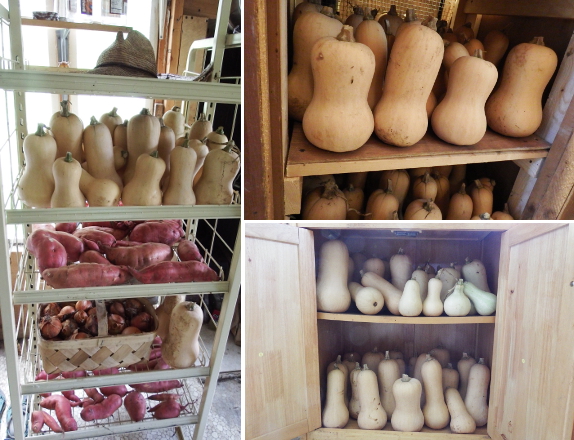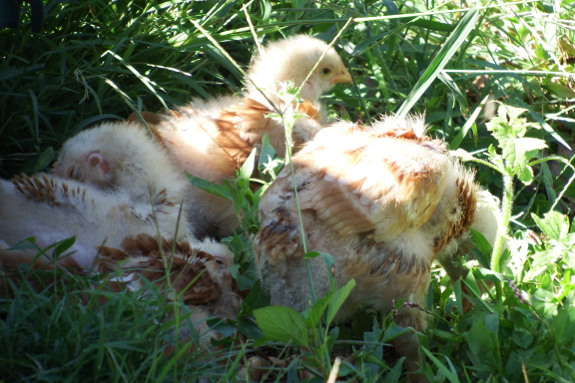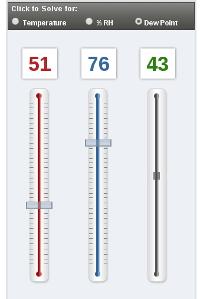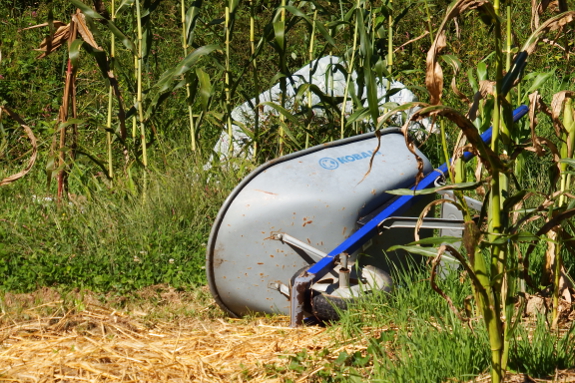
Estimating minimum temperatures with the dewpoint

Just in case, we prepared
for a potential early freeze by bringing in all of our storage
vegetables off the porch. Some were ready to enter their final storage
locations, while others need another couple of weeks curing on the rack.
(And, since someone asked last week and I forgot to reply to their
comment --- if you're curious about how to cure and store vegetables
that don't require fancy preservation, you can read everything I know in
Weekend Homesteader: October.)

Next we covered up our
pepper plants (the only summer crop that hasn't already reached quota in
the preservation department) and settled in to wait for the Monday low.
 Okay,
I lied. I can't wait worth a darn, so I instead finally researched a
topic I'd read a little bit about but never really delved into --- the
dewpoint temperature. The idea is that gaseous water starts turning
liquid at a certain temperature, and in the process a lot of heat is
released. That release of heat makes it very difficult for
moisture-laden air to drop below the dewpoint temperature. So unless a
cold front is blowing in, you can guess the night's minimum temperature
by using temperature and humidity at sunset to calculate the dewpoint. Here's a website that does the math for you.
Okay,
I lied. I can't wait worth a darn, so I instead finally researched a
topic I'd read a little bit about but never really delved into --- the
dewpoint temperature. The idea is that gaseous water starts turning
liquid at a certain temperature, and in the process a lot of heat is
released. That release of heat makes it very difficult for
moisture-laden air to drop below the dewpoint temperature. So unless a
cold front is blowing in, you can guess the night's minimum temperature
by using temperature and humidity at sunset to calculate the dewpoint. Here's a website that does the math for you.
Did my calculations work?
Sunday night, it was 51 degrees with 76% humidity...and Monday at dawn
it was 43 degrees outside. Exactly as estimated!
Of course, Tuesday was a
little bit different. My weather guru had explained that our valley
location means that the second day in a cold spell often attains lower
temperatures than the official forecast. I can't recall his exact
reasoning, but I think the deal is that the cold air from the previous
day gathers in the mountains above us then flows down into our valley
that second night. Sure enough, the second day of our cold spell saw
temperatures a few degrees lower than our dewpoint estimate...but still
above freezing. Phew!

Okay, I say I'm
relieved...but I'm actually just about ready for the gardening season to
wind down. But it's worth a bit more pushing at this time of year to
grow organic matter rather than weeds in fallow garden beds. So my tired
wheelbarrow will get back to work for a few more weeks, and then we'll
both enjoy our much deserved winter rest.
Want more in-depth information? Browse through our books.
Or explore more posts by date or by subject.
About us: Anna Hess and Mark Hamilton spent over a decade living self-sufficiently in the mountains of Virginia before moving north to start over from scratch in the foothills of Ohio. They've experimented with permaculture, no-till gardening, trailersteading, home-based microbusinesses and much more, writing about their adventures in both blogs and books.
Want to be notified when new comments are posted on this page? Click on the RSS button after you add a comment to subscribe to the comment feed, or simply check the box beside "email replies to me" while writing your comment.
